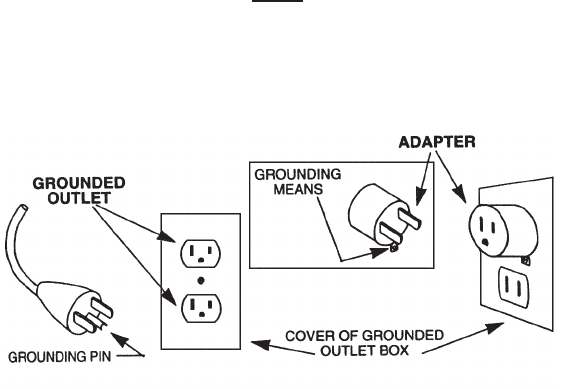
• 4 •
not having an output voltage selector switch, determine the voltage of
the battery by referring to the vehicle owner’s manual and make sure it
matches the output rating of the battery charger.
4. AC POWER CORD CONNECTION INSTRUCTIONS
4.1 The charger must be grounded to reduce the risk of electric shock. The
charger is equipped with an electric cord having an equipment grounding
conductor and a grounding plug. The plug must be plugged into an outlet
that is properly installed and grounded in accordance with all local codes
and ordinances.
DANGER: NEVER ALTER CHARGER’S ORIGINAL AC CORD OR
PLUG. IF THE PLUG DOES NOT FIT OUTLET, HAVE PROPER
OUTLET INSTALLED BY A QUALIFIED ELECTRICIAN. IMPROPER
CONNECTION CAN RESULT IN THE RISK OF AN ELECTRIC SHOCK.
DISCONNECT THE PLUG FROM OUTLET WHEN CHARGER IS IDLE.
4.2 This battery charger is for use on a nominal 120-volt circuit and has a
grounding plug that looks like the plug illustrated in Figure A. A temporary
adapter, which looks like the adapter illustrated in Figures B and C, may be
used to connect this plug to a two-pole receptacle as shown in Figure B, if
a properly grounded outlet is not available. The temporary adapter should
be used only until properly grounded outlet can be installed by a qualied
electrician.
DANGER: BEFORE USING AN ADAPTER AS ILLUSTRATED, BE
CERTAIN THAT THE CENTER SCREW OF THE OUTLET PLATE
IS GROUNDED (D). THE GREEN-COLORED RIGID EAR OR LUG
EXTENDING FROM ADAPTER MUST BE CONNECTED TO A
PROPERLY GROUNDED OUTLET. MAKE CERTAIN IT IS GROUNDED.
IF NECESSARY, REPLACE THE ORIGINAL OUTLET COVER PLATE
SCREW WITH A LONGER SCREW THAT WILL SECURE THE
ADAPTER EAR OR LUG TO THE COVER PLATE AND MAKE THE
GROUND CONNECTION TO THE GROUNDED OUTLET.
(D)
(A)
(C)
(B)


















